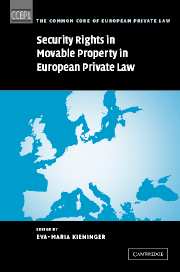Book contents
- Frontmatter
- Contents
- General editors' preface
- Preface
- List of contributors
- Table of cases cited by name
- Table of legislation
- Part I Introduction and context
- Part II The case studies
- List of abbreviations
- Bibliographies
- Glossary
- Case 1 Furniture for a new office
- Case 2 The deceived seller
- Case 3 Machinery supplied to be used by the buyer
- Case 4 Jackets for resale
- Case 5 Motor cars supplied and resold (I)
- Case 6 Motor cars supplied and resold (II)
- Case 7 Supply of material to manufacturer (I)
- Case 8 Supply of material to manufacturer (II)
- Case 9 Too many toasters
- Case 10 Bank loan on the basis of a car fleet
- Case 11 Bank loan for a wholesaler
- Case 12 Bank loan on the basis of money claims (I)
- Case 13 Bank loan on the basis of money claims (II)
- Case 14 Finance leasing of computers
- Case 15 Indebted businessman sells business to brother
- Evaluation: a common core? Convergences, subsisting differences and possible ways for harmonisation
- Index by country
- Index by subject
Case 7 - Supply of material to manufacturer (I)
Published online by Cambridge University Press: 23 December 2009
- Frontmatter
- Contents
- General editors' preface
- Preface
- List of contributors
- Table of cases cited by name
- Table of legislation
- Part I Introduction and context
- Part II The case studies
- List of abbreviations
- Bibliographies
- Glossary
- Case 1 Furniture for a new office
- Case 2 The deceived seller
- Case 3 Machinery supplied to be used by the buyer
- Case 4 Jackets for resale
- Case 5 Motor cars supplied and resold (I)
- Case 6 Motor cars supplied and resold (II)
- Case 7 Supply of material to manufacturer (I)
- Case 8 Supply of material to manufacturer (II)
- Case 9 Too many toasters
- Case 10 Bank loan on the basis of a car fleet
- Case 11 Bank loan for a wholesaler
- Case 12 Bank loan on the basis of money claims (I)
- Case 13 Bank loan on the basis of money claims (II)
- Case 14 Finance leasing of computers
- Case 15 Indebted businessman sells business to brother
- Evaluation: a common core? Convergences, subsisting differences and possible ways for harmonisation
- Index by country
- Index by subject
Summary
(Retention of title and products clause – property effects of manufacturing)
B is a producer of curtains and other decorative items. A sells 500 rolls of cloth to him. The contract contains the following clause: ‘The seller reserves title to the goods sold under this contract until he has received full payment.’ In the two weeks following delivery, B transforms the cloth into curtains. Of the final value of the curtains, 60 per cent can be attributed to the cloth, the remaining 40 per cent to the manufacturing process. Before the curtains are sold and delivered to B's customers, a bailiff, acting on behalf of an unsecured creditor, C, attempts to execute against B's property, including the curtains.
Questions
(a) Who owns the curtains? Does the ratio of the value of the material supplied and the value added by the manufacturing process matter? Does it matter who bears the risk of the manufacturing process, A or B?
(b) May the newly produced items be subjected to execution on behalf of C?
(c) Could A obtain a better right to the products (for example, by adopting a differently worded clause, or by using a different type of retention of title clause, or through a legal transaction other than pure sale)? What would be the precise prerequisites? Are such arrangements commonly used?
(d) Instead of an unsecured creditor attempting to execute against B's property, B goes bankrupt. What are the answers to parts (b) and (c) in that situation?
- Type
- Chapter
- Information
- Security Rights in Movable Property in European Private Law , pp. 365 - 397Publisher: Cambridge University PressPrint publication year: 2004



